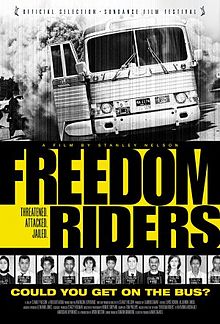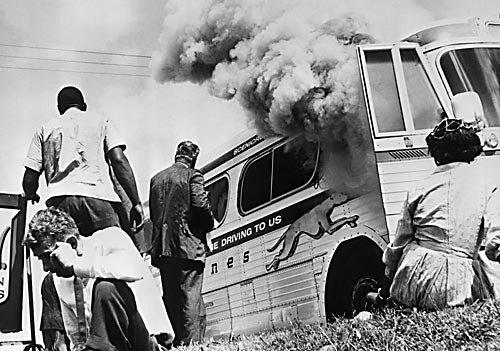If one is serious about fighting institutionalized racism and white supremacy, then one must be prepared to take risks. This is exactly what Walter Bergman, a retired teacher had done in May of 1961, when he decided to be part of the first wave of Freedom Riders. (Bergman is the second from the right standing)
Freedom Riders was a project organized by the Congress of Racial Equality, known as CORE. The idea was to have black and white people ride buses in southern states to challenge the Jim Crow segregation policies that still plague much of the south.
Bergman, a long time teacher and education administrator in Detroit had seen plenty of racial injustice in his lifetime and had decided that he needed to take the next step and fight the white supremacist policies that were deeply entrenched in this country. Walter had retired in 1958 and began working with CORE on issues within the city, like picketing the international headquarters of the Kresge Corporation for their racists practices.
In February of 1961, CORE organized a conference in Kentucky, which Bergman attended. It was at this conference that CORE laid out their plans to have freedom riders challenge racist policies in the south. Even though Bergman was 61 at the time, he felt compelled to participate, so he and his wife signed up to be part of the first wave of Freedom Riders later that spring.
The Freedom Riders left Washington, DC on May 4th, 1961 and began their journey south. They encountered verbal abuse and opposition all along the way, but on May 14, after arriving at the Greyhound bus terminal in Anniston, Alabama, the freedom riders experienced physical violence.
Any angry group of white men had been waiting at the bus station and shortly after the bus pulled in to the terminal, the men began to attack the bus, breaking its windows and slashing tires, and then pursuing it until the driver was forced to stop because of flat tires several miles out of town.
The mob of white supremacists had followed the bus out of town in a caravan of cars and when they saw that the bus had stopped due to several flat tires, they exited from their cars and began attacking the bus again. This time, someone threw an incendiary bombs on the bus, which caught on fire. Despite the flames, some of the white men entered the bus and began beating some of the riders, only to be forced off the bus by an undercover cop who confronted them at gunpoint.
Rev. Fred Shuttleworth, an organizer and leader within the Southern Christian Leadership Conference, sent an armed group to where the burning bus was outside of Anniston, to escort the freedom riders back to town. Some of the freedom riders went to the hospital to have their wounds tended to.
The second bus, the one that Bergman was one, was a Trailways bus. This bus arrived in Anniston about an hour after the Greyhound bus. When the bus pulled into the terminal, there were closed signs posted and the terminal looked empty, except for a few police officers at first. Eventually the police officers entered the bus and told us to change seats, meaning they wanted to use to sit with whites in the front and blacks in the back, as was the policy in many southern states.
The freedom riders didn’t move, but several white men who had been on the bus since Atlanta, stood up as if to comply, when in fact they began attacking the freedom riders, along with other white supremacists who had arrived at the bus station. It was discovered later that the white men who had been on the bus since Atlanta, were members of the KKK, who had planned to ride along and attack the freedom riders at an opportune time.
Bergman’s description of the attack can be read in the book, The Price of Dissent: Testimonies to Political repression in America. The attackers had hammers and clubs and began beating several of the riders, include CORE member Jim Peck and Walter Bergman. Bergman, was beaten pretty severely and was lying unconscious for a period of time. Raymond Arsenault, in his book, Freedom Riders, described what happened next:
Although Walter Bergman’s motionless body blocked the aisle, several Klansmen managed to drag Person and Harris, both barely conscious, to the back of the bus, draping them over the passengers sitting in the backseat. A few seconds later, they did the same thing with Peck and Bergman, creating a pile of bleeding and bruised humanity. Content with their brutal handiwork, the Klansmen then sat down in the middle of the bus to block any further attempts to violate the color line. A black woman riding as a regular passenger begged to be let off the bus, but the Klansmen forced her to stay. “Shut up, you black bitch,” one of them snarled. “Ain’t nobody but whites sitting up here. And them nigger lovers can just sit back there with their nigger friends.”
It is important to note at this point, that the whole time the white supremacist had been beating the freedom riders, that the cops who were standing just outside the bus did nothing.
Eventually the white men stopped attacking the riders and allowed the bus to leave the terminal and make its way to the Birmingham. When the bus arrived in Birmingham, there was another group of white supremacists waiting to meet them. Again, these white men boarded the bus and began beating the freedom riders, both black and white. The white supremacists also used the opportunity to attack black people who just happened to be at the bus terminal waiting to depart for a different destination.
Bergman then talked about how he was then helping Peck, who was bleeding badly, and trying to get him to a hospital. Bergman was able to flag a taxi and got Peck to a hospital, where they stitched him up. However, the hospital staff told them to leave because, “It wouldn’t be safe for them there.”
The freedom riders were able to find safe haven in Rev. Shuttleworth’s church. People from the congregation had come to offer support and to hear testimony from the freedom riders. While people were meeting in the church, more white supremacists had gathered outside. Bergman says that people in the church just began singing and eventually the mob left.
The next day the freedom riders decided to take the next bus and head to Montgomery, which was the next stop on their route. The first Greyhound to arrive at the station refused to take the freedom riders, as did the next and the next. After some deliberation the group decided to just take a plane to their final destination, which was New Orleans. There was a caravan of cars to take them to the airport and Bergman recounted how the men driving their vehicles had open their hoods and crawled under the cars before starting their engines. When asked why they were doing this, they replied, “It is just standard operating procedure, to make sure there are no bombs on the car.”
The caravan took them to the airport, where another group of white supremacists were waiting for them. Undeterred, the freedom riders got on the plane, only to have to get off after just a few minutes because of a bomb threat that was reported. The flight was cancelled, along with the next one. Rev. Shuttlesworth had called the US Attorney General’s office and convinced Bobby Kennedy to send a plane to Birmingham that would eventually take the group to New Orleans.
About a week after the attacks, Walter Bergman had a stroke, brought on by the blows to the head. The severity of the stroke left Bergman disabled, forcing him to use a wheel chair for the rest of his life.
I met Walter Bergman in the early 1980s while while protesting US military intervention in Central America. Walter was a regular at the weekly protests held in downtown Grand Rapids. I got to know Walter even better when I was co-editing a newspaper and would deliver his copy to the retirement home he and his wife were living at in the northwest part of Grand Rapids. Walter would always invite me in and want to talk about current politics. He would always ask me what I was reading and said that it was our duty to constantly be learning and figuring out ways to be part of the struggle for justice.
With the help of the ACLU, Bergman and his wife and filed a lawsuit against the federal government in 1977, on the grounds that they believed that the FBI was complicit in the attacks against Walter. After years of litigation and investigation, the courts decided in his favor and awarded him a settlement. The judge found the FBI to be guilty of wrong doing, since they knew about the plans by the KKK to attack the freedom riders, but did nothing to prevent them attacks from taking place.
Walter Bergman continued to be active in social justice struggles and lived to be 100 years old. Walter passed away in 1999 and a memorial service was held for Walter at the Fountain Street Church.
Here is a 9 minute video that was produced some 20 years ago to honor the witness and commitment of Dr. Walter Bergman.




Pingback: Print Celebrates 1960s Freedom Rider from Grand Rapids, Walter Bergman | Grand Rapids People's History Project
Respect!
LikeLike